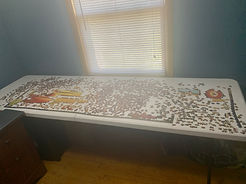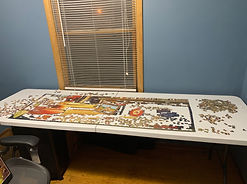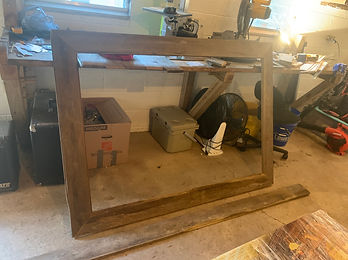Big Sky Saloon

TL;DR
I finished a 6,000-piece puzzle and built a custom frame to match its rustic scene.
I also share my mistakes and tips (🧩) for how to avoid them in the future.
Lessons Learned (Top 3)
-
Find the low-hanging fruit
-
Organize, Reorganize, Repeat
-
Give yourself space
Fun Fact
Costco sells a 60,000-piece puzzle that measures 8 feet wide and 29 feet long. It comes in 60 - 1,000 piece puzzles that can be connected and costs $350 at the time of this writing.
Background
I've always liked puzzles. Maybe it's seeing everything fit perfectly or perhaps the sense of accomplishment when finishing one. I'm not sure what it is, but I've enjoyed them as far as I can remember. My mom even tells stories about how as a toddler I could be found sitting quietly in a room by myself on the floor, doing a puzzle. To this day, I wonder what impact those moments had on my future.
In 2015, I was living in an apartment on the west side of Cleveland. In addition to being near some of the trendiest places in the city, there was also a busy park across the street and downtown was only a short drive away. Between these alone, there were plenty of opportunities for entertainment throughout most of the year. I point out "most of the year" as the weather in Cleveland changes significantly during winter months and indoor activities quickly become more appealing.
It was during one of these winters that I would start a 6,000-piece puzzle called Noah's Ark (yes, puzzles have names). It was also by far the largest puzzle I'd attempted, and it took nearly two years (working intermittently) to complete. As I got closer to the finish, I decided that it wouldn't be something that I'd ever want to put together again. So instead of taking it apart and putting it back into the box, I would end up gluing it, framing it, and gifting it to my father. To this day it hangs in his garage and collects an occasional "ooh" or "aah" at family gatherings.

I remember telling myself I'd probably never do something like that again, mainly due to the time commitment. However, only a few months later I was showing the very picture above to a childhood neighbor/lifelong friend and it wasn't long before we were both looking at puzzles on the internet. The selection is nearly endless, and even if puzzles aren't your thing, I'll be willing to bet there's still one out there that appeals to you for one reason or another. Sure enough, my friend found one that he was instantly attracted to. It was cool, a scene of an old western saloon and all of the things that come with it. I decided to buy the puzzle that night with the intent of doing something similar to the Noah's Ark puzzle. I also decided not to tell anybody as I wasn't sure it would happen. Barring a pandemic, it probably wouldn't've.

It was almost a year into COVID, and as expected, the Cleveland winter wasn't helping anybody's social life. For most, entertainment was probably pretty limited. For me, it was a great opportunity to sift through years of random purchases stored in the walk-up attic. It wouldn't be long before I came across a record player and the Big Sky Saloon puzzle. I'd found my entertainment for the foreseeable future.
Getting Started
Starting a puzzle is fun. It's like the start of a road trip, a movie, or anything else where optimism and anticipation translate to a fair amount of excitement. You get to open the box, dump out all the pieces, and complete the border in what seems like a quick win.
Large puzzles are a little different where the pieces come in a bag the size of a briefcase. It doesn't seem like much at first, but as you begin dumping out the pieces you realize there's a lot more there than you'd thought. You begin sifting through the pieces only to notice that the border pieces are fairly dispersed in the sea of shapes that you were given. It was a reminder of why I was hesitant to start another puzzle of this size.
Nonetheless, with the record player going, I dumped out the bag and started sorting the pieces.
🧩 It's tempting to finish the border before moving to the center, but with puzzles this large, you end up wasting a lot of time searching for a specific piece (or few) and you're better off moving to one of the interior sections after your initial sort. I also highly recommend making sure you have enough space at this point. If you find yourself searching for pieces by sifting through the puzzle box like I did, it probably means you could use another table.


With most of the edges complete it was time to start going after the low-hanging fruit. My strategy involved starting with areas of the puzzle that had unique characteristics/colors as they had fewer pieces and finishing them first would mean sifting through fewer pieces. The approach wasn't bad, however, It was becoming clear that there wasn't enough space.
When I sorted the pieces initially, I did so by putting them into separate bags and bowls which I could then come back to at a later time. I was making progress, but it seemed like I was spending more time searching for pieces rather than putting them together. This is where the extra table is a necessity. Having enough room so that you can put all of your pieces out (face up) is the single most important step in doing larger puzzles. It not only helps you find pieces with just a spec of that color you're working on, but it also helps you further sort colors that look similar in the bowl, but when put next to each other on a table, clearly come from different parts of the puzzle.
Using a table from the garage and another I bought from the store, the pieces were spaced out and resorted. They were now in three separate rooms, but they were also much easier to manage.



🧩 If space is limited or you can't leverage a shared space like the kitchen table, pieces can be put on a movable surface such as a 1/8" sheet of sanded plywood that you can buy from your local home store. Most will even cut it for you if you can't fit it into your car or you need a specific size.
With the additional tables now in place, things were moving along. Section by section, you could see the scene coming together and the visual progress seemed to provide additional motivation to continue. Even the parts that I wasn't looking forward to were providing some sense of enjoyment.



🧩 Eventually, large sections of the puzzle need to be moved into place and connected with the rest of the puzzle. Instead of moving the entire section to determine if it fits, take a single piece from the edge of the section and try it first. This prevents you from moving a large section only to find it doesn't fit where you think it does.
At this point, the only remaining sections are the ceiling, floor, and bar. And as expected, they were also the more difficult and less enjoyable sections of the puzzle. Progress was slower in these areas, but I still had the record player going and the quickly approaching spring weather was an incentive to push through. The end was close.


🧩 The more pieces a puzzle has, the lower the contrast will be between pieces and the easier it is to think that a group of pieces goes together when they don't. This is where it's important to continually sort the pieces and look at the texture in addition to the color. You can (and should) also group the pieces by the amount of grooves it has, helping you identify which set of pieces contains the one you're looking for.
🧩 The box can also be immensely helpful (yes, the box!). If you're stuck and wondering why a particular section isn't fitting where you think it does, check to see if maybe you have a different section of the puzzle than what you thought. The box can help you find this.
It was down to the last few pieces and there was a sense of relief that the puzzle would soon come to an end. After combining the top and bottom
sections on a sheet of sanded plywood, a couple of layers of puzzle glue were added to hold it all together and it was time to begin thinking about the framing. Big Sky Saloon required little more than two months to complete, considerably less than the two years that Noah's Ark would take (the latter was significantly harder due to the darker colors).





Framing
The puzzle was complete but there was still a large task ahead in making the frame. I'd made the frame for Noah's Ark when I was quoted $700 (which included a 40% discount) from a craft store to complete, so I was vaguely familiar with what would be required. I wanted to make a frame that matched the scene and I decided to use reclaimed barn wood for the material. Living in the Midwest, it's easier to find reclaimed barn wood than one might think. In fact, one look on Facebook marketplace revealed several results that looked promising. I found a listing where the person had a large pile left over from another project. It was an hour away, but it was cheap, and for less than $50, I was able to get more than enough for the project (check out the Dog Saloon project to see what was done with the leftovers).
I started by finding several pieces that would make the border of the frame. There were only a handful of candidates as most pieces either weren't long enough or were warped to the point of being unsuitable for the frame. However, after laying out several of the boards, I picked a few that were sufficient and moved on. The pieces were lightly sanded, cut, and assembled to make a basic rectangular frame.

Using a couple of the remaining boards, I created a second frame with an inlay that the puzzle would sit in. Enough room was also provided to include a thin sheet of acrylic plexiglass for additional protection.


A bracket was built and added to the back for additional support. This would not only make the piece much easier to move by a single person, but it would also provide an even surface for the mounting brackets required to hang the piece. The last step was to cut the acrylic plexiglass, lay the puzzle/plexiglass into the backdrop, and attach the border with a few screws from the backside.


Conclusion
Making something unique can be rewarding and enjoyable, especially when others find enjoyment in it as well. The finished piece hangs in my friend's basement today and collects a familiar "ooh" or "aah" reaction at social gatherings. Whether people actually like it or it's just a natural reaction to seeing something completely different, it's hard to deny that it makes for a fun conversation piece.
